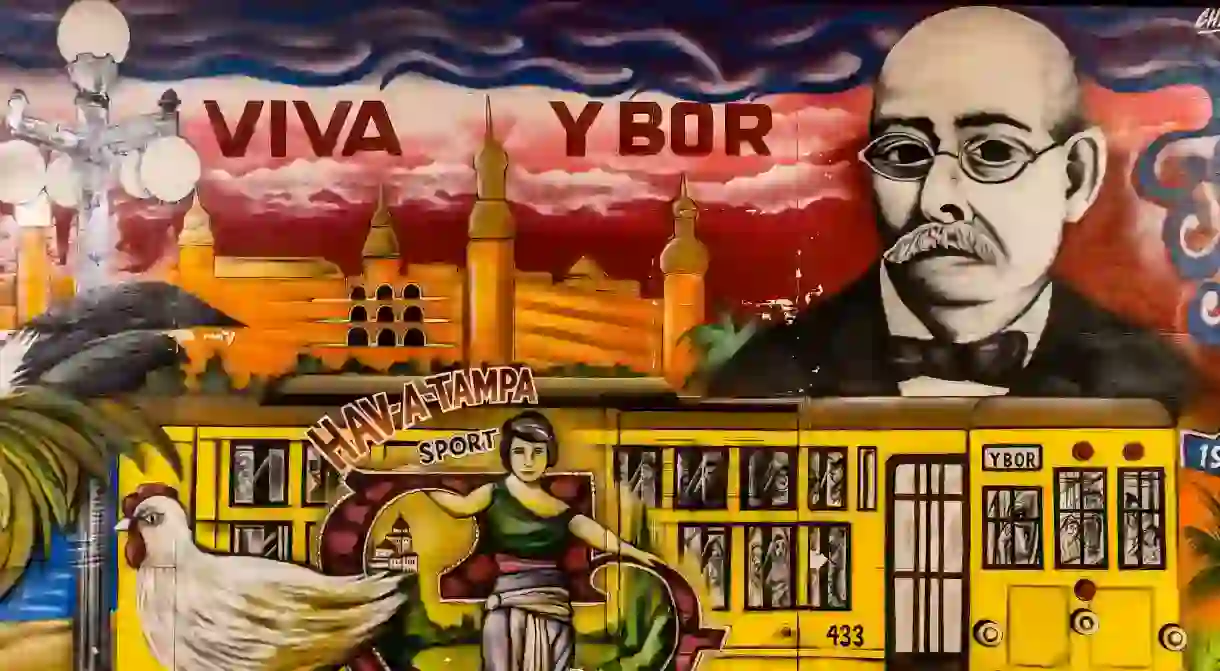A Walking Tour of Ybor City's Architectural Gems

Known for its old-world vibes, this vibrant little neighborhood is certainly one of Tampa’s hidden treasures.

Tampa’s Ybor City is home to a diverse blend of cultures and contains more than 950 historic buildings and structures. Founded in 1885, the neighborhood was once known as the “Cigar Factory of the World,” after Spanish-American entrepreneur Vicente Martinez-Ybor opened up his famous Ybor-Manrara Cigar Factory.
In order to support the then-booming cigar industry, Spanish, Cuban, and European immigrants flocked to the city and helped put Tampa on the global map. As a result, most of the early 20th-century buildings have distinct Spanish, Cuban, and Italian influence. Despite the closure of the cigar factories, the city is far from abandoned—an eclectic energy still permeates the cobble-stoned streets, which are lined with vintage and niche shops, theaters, trendy restaurants, and historical sites. The area officially became a U.S. National Historic Landmark District in 1974.
Here are a few historic gems to check out in Ybor City…

Columbia Restaurant: “The oldest, continuously operating restaurant in Ybor City”
At over 110 years old, the Columbia Restaurant is Florida’s oldest restaurant and has been in the same family for nearly five generations. Founded in 1905, what started out as a 60-seat corner cafe, now encompasses an entire city block and holds the title of the world’s largest Spanish restaurant.
After several renovations, including a US$6.5 million (around UK£5.1 million) renovation project back in 2005, the historic site can now seat nearly 1,600 people. The exterior displays an intricate array of colorful Spanish tile murals, while the interior features original Spanish tile floors, a traditional Spanish inner courtyard with a fountain and terraced balconies, among its many rooms. Owned and operated by the great-grandchildren of the original founder, Casimiro Hernandez, this historic site represents some of America’s best Spanish design.

El Centro Español de Tampa
Because of Ybor’s rapid influx of immigrants during the early 20th century, mutual aid society buildings were built to provide much-needed health aid (before the days of insurance) and to create a sense of community within the newly burgeoning city. Originally constructed as a two-story, wood-frame club house in 1892, El Centro Español de Tampa was later rebuilt in Ybor’s signature red brick in 1912 to encompass the club’s expanding membership.
According to the National Park Service, the architectural style is “a combination of Spanish, Moorish, and French renaissance.” Today, El Centro Español de Tampa houses restaurants, business, an improv comedy center, and a gift shop. This historic site is a surviving testament to the strength of Spanish immigrant roots and community in Ybor City.

The RITZ (Rivoli) Theater
Originally built as the Rivoli Theater in 1917, this Ybor theater historically served the Afro-Cuban community and was added to the National Register of Historic Places in 1973. The exterior features Ybor’s signature second-story balconies, while the interior features art deco mirrors and wall sconces. The Grand Foyer connects three distinct rooms: the Royal Room, the Rivoli Room, and the Theatre Ballroom.
The space has gone through several changes since its initial construction: it became the RITZ Theater in the 1930s and then became a nudie theater in the late-60s. Later, it became The Masquerade, a concert and nightclub, before undergoing a US$2 million renovation (around UK£1.5 million) and reopening again as The RITZ Ybor in 2008.

Ybor Factory Complex : the first cigar factory in Ybor City (the Ybor-Manrara Cigar Factory, 1886)
Ybor City received its name from cigar factory owner Vicente Martinez-Ybor after he moved his company’s headquarters from Key West to Tampa in 1885. Built in 1886 and reportedly designed by architect C.E. Parcell, The Ybor-Manrara Cigar Factory complex takes up an entire city block between 13th and 14th street. Part of the complex was the site of Ybor’s first cigar factory and the building was added to the U.S. National Register of Historic Places in 1972.
In its heyday The Ybor-Manrara Cigar Factory was the largest in the world, and over the years has housed galleries, studios, a festival marketplace, and offices. Today, it serves as the site of the Church of Scientology, after the religious organization purchased the building in 2010.

El Centro Asturiano de Tampa
Established in 1902, El Centro Asturiano de Tampa was originally a Spanish social club (like El Centro Espanol de Tampa), but it also functioned as one of the state’s earliest hospitals. After the original site burned down in 1912, a new three-story yellow brick structure was erected and designed in the neoclassical style. The first floor originally featured a gymnasium, a cantina with a marble onyx bar, a billiard room and a three lane bowling alley, while the second contained a library, reading and educational rooms, ladies’ parlor and dressing room, and a theater. Today, the building features classical columns and a grand ballroom and is the site for weddings, quinceañeras (a celebration of a girl’s coming of age), and other private events.














